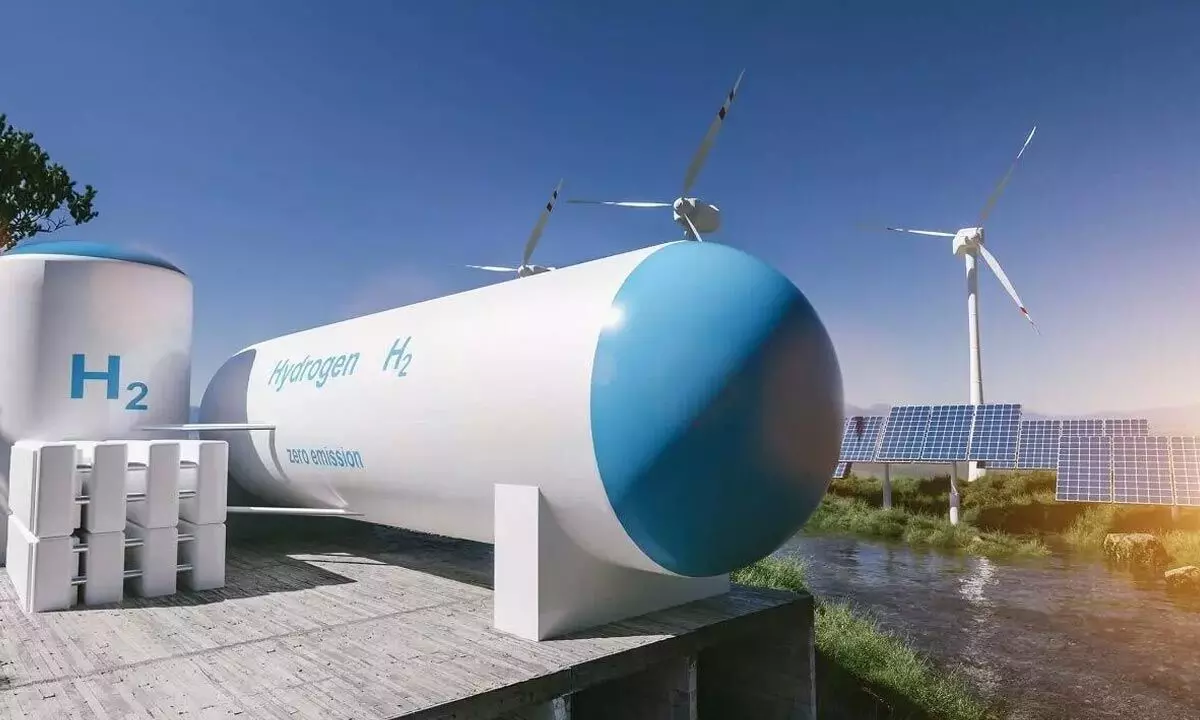Is Green hydrogen the fuel of the future?
Green hydrogen is the name given to hydrogen gas that has been produced using renewable energy, such as wind or solar power, which create no greenhouse gas emissions
image for illustrative purpose

Hydrogen gas can be used as a fuel in transportation, power generation and industrial activities. It does not release greenhouse gas emissions such as carbon dioxide when it is burned. Green hydrogen is the name given to hydrogen gas that has been produced using renewable energy, such as wind or solar power, which create no greenhouse gas emissions.
Hydrogen is not just another fuel. Hydrogen is expected to serve as a primary industrial fuel in the 21st century, just as coal drove the 19th century and oil drove the 20th century. In a fuel cell – a device that converts the energy of a chemical into electricity – hydrogen gas reacts with oxygen to produce electricity and water vapour. Because of hydrogen's capacity to generate energy without releasing greenhouse emissions, it is a potential clean alternative to fossil fuels.
Hydrogen is the most abundant chemical element in the universe. Despite its abundance, hydrogen does not naturally exist as a gas in usable quantities, occurring almost entirely in compounds, such as water. Therefore, hydrogen must be produced using industrial methods. Most of these involve the reforming of natural gas – a fossil fuel. Other methods exist, including a process called electrolysis, whereby an electric current is used to split water into its basic components: hydrogen and oxygen.
While hydrogen gas does not emit greenhouse gases when burned, the electricity used to produce it, whether via electrolysis or other processes, may have been generated by fossil fuels. This is commonly known as 'grey hydrogen', which currently accounts for 95 per cent of the total production.
Hydrogen produced using electricity generated by burning fossil fuels, such as coal and gas, but paired with carbon capture and storage (CCS) technologies, which trap the carbon emissions released in the process and prevent them from entering the atmosphere, is labelled 'blue' hydrogen.
Green hydrogen is obtained through electrolysis powered by renewable electricity, generated through technologies such as solar panels or wind turbines. 18 per cent of global energy demand could be met by green hydrogen, 30 million people could be employed in the hydrogen industry and $2.5 trillion is potential revenue from hydrogen and technology sales.
According to the International Energy Agency (IEA), India's huge potential for renewable energy production, green hydrogen production costs could compete with that of hydrogen generated through fossil fuels within this decade. This transition could enable the export of low-carbon hydrogen and hydrogen-based fuels to Asia-Pacific based economies.
India is aiming for carbon neutrality by 2070. The path to energy security goes through a mix of oil, coal, blended fuels, natural gas, renewables, and electricity. As per Niti Aayog, $3.1 trillion economy needs 1,650 billion units (BU) of power, made from nearly 400 GW of capacity. Of this, green electricity is only 17 per cent. Global demand for hydrogen is 70 million tonnes. Demand in India by 2030 will be 11 million tonnes H2.
Green hydrogen cannot replace renewable power, but production of green hydrogen will be greatly enabled by solar energy. Last year, the government launched the country's first green hydrogen policy. The objective is to reduce fossil fuel usage and increase penetration of green fuels.
Now, India has the advantage of low cost. The cost of green hydrogen in the country is expected to fall to about one-fourth of global levels. At about $1 per kg, India could become the lowest-cost producer in the world.
Water availability: For producing one kg of hydrogen, nine kg of water as input is required. Accordingly, a large-scale (1 GW) electrolyser, producing 0.15 million tonne of hydrogen, would consume about three million tonne of water. Hence shortage of water can be a key hindrance in green hydrogen manufacturing.
Many fuels are flammable. Compared to gasoline, natural gas, and propane, hydrogen is more flammable in the air. A concern is the higher energy content of hydrogen poses risks as auto fuel. Auto fuels are highly flammable. A vehicle laden with hydrogen will be more vulnerable in case of a major accident.
A shift to green hydrogen as a new renewable source won't happen in a hurry, as energy transitions, in general, take a long time. Over the course of 60 years - starting from the time it was introduced between 1840 and 1900 - coal went from 5 per cent of the world's energy supply to nearly 50 per cent. But in the 60 years from 1930 to 1990, natural gas reached just 20 per cent. So, the transition to hydrogen will also take time.
It's a great chance for India to innovate and cash in on the latent demand for new age fuels. Indian companies have missed many technology-led innovations in the past. Green hydrogen presents India with an opportunity to lead the change.

